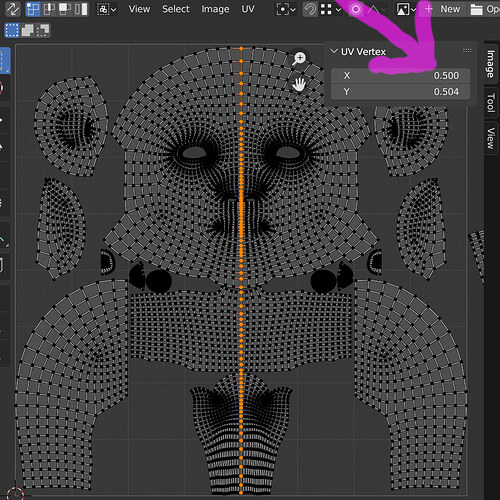Over ten years ago, when I was first puttering around with making my own 3D stuff, I learned a few things that were presented as This Is The Way for ALL 3D work. Of course, no they weren’t – useful as “good” all-quads is it’s not what 3D games use, and so on. One of those things was: if your UV map has an island for a symmetrical part of the mesh centered on a given axis, then “good” UV design requires that the island also be symmetrical, and its centerline verts be exactly centered on that axis. This allows for separate 2D software to more easily create a texture map by mirroring across the same axis. (Any asymmetry to be added later if at all.)
The usual example was a human mesh, left-right symmetrical – the UV-mapped head and torso islands centered on the V (aka X) axis, every centerline vertex in them exactly centered on that axis to the most decimal places the software supported. The limbs and such might be mirrored across the axis, or scattered around the remaining space in a denser packing scheme, but the head and torso islands were always given exact X-axis central pride-of-place in any “good” UV map.
Blender’s Human Base Meshes Asset Bundle, assembled from the contributions of various volunteers, has some UV maps that follow this principle and some that don’t. I recently suggested that Suzanne’s upcoming UV map follow this principle – when writing that topic it would’ve been helpful if I could’ve cited documentation, tutorials, posts, etc, however old, recommending this methodology.
I can’t find any. Like, not anything. I don’t remember where I learned this, I’ve looked everywhere I can still get into that I was on back then, I’ve gone over TurboSquid’s best practices again, I’ve googled and asked the duck with every search term I can dredge up. ![]() I’ve got nothing.
I’ve got nothing.
I can understand it’s been depreciated! Innovations in both 2D texture creation and 3D baking make it a lot less important than it used to be. But it’s not just a fig newton of my imagination – people are still doing this, they had to have learned it somewhere, right? ![]()
So, anybody out there? If you do/did this, and remember where/when/why/who/whatever? I’d appreciate it if you’d let me know. ![]()

